Auckland floods: city begins clean up after ‘biggest climate event’ in New Zealand’s history

Insurers say devastating flooding in Auckland was the “biggest climate event” in New Zealand’s history, as rain eased after days of downpours and a clean-up of the city began.
Friday was the wettest day on record for New Zealand’s largest city, with severe rain leading flood waters to sweep through streets and down highways, killing four people. Schools and businesses closed as buildings and roads were ravaged by the deluge. Auckland International Airport was shuttered temporarily, stranding thousands of travellers overseas.
The finance minister, Grant Robertson, told reporters in Auckland on Wednesday that the deluge would be the “biggest non-earthquake event” in terms of insurance that the country had ever recorded. He did not have estimates yet for the likely cost of the damage.
His remarks came as rain eased in the city of 1.6 million people – though renewed downpours caused more damage overnight – and attention turned to assessing the scale of the chaos.
At least 20,000 claims have already been lodged, a spokesperson for the Insurance Council of New Zealand told the Guardian, with numbers expected to keep rising for weeks.
As the water receded, evidence of a sodden and wrecked city emerged: officials have placed red placards on 138 buildings – meaning entry is prohibited without council consent – while yellow placards restrict the use of 542 others. Inspections of structures are due to be complete by the end of the week.
Landslides and sinkholes still threaten homes. Three people were taken to hospital on Wednesday afternoon – two of them seriously hurt – after a house in Orua Bay, a rural Auckland township, crashed down a bank on to the beach, trapping one person inside.
More than 600 flood-damaged cars have been removed from the city’s roads, said Rachel Kelleher, Auckland’s emergency management deputy controller. Across the city, fallen trees, debris and mud litter streets where last Friday, residents waded through chest-deep water or paddled kayaks to safety.
Schools and early learning centres – which were closed this week by an education ministry order – will be permitted to open on Thursday if they wish.
Parts of the city’s motorway system remain flooded and a number of rail lines are not operating.
Auckland is still in a state of emergency, with officials to reconsider the designation on Friday. There are no longer any weather warnings in place for the city.
Heavy rain warnings remain in place for the Coromandel peninsula, east of Auckland, where state highways are closed and houses are teetering on the edge of slips. Alerts have been lifted for Bay of Plenty and Northland.
Forecasters had warned of heavy rain in Auckland ahead of Friday’s deluge, but the frightening speed and volume of the downpour – which saw 250mm of rainfall in parts of the city’s north, south and west – took many by surprise.
A slow-moving subtropical low-pressure system over Auckland unleashed the torrential rain, which was intensified by humid La Niña conditions and a marine heatwave that had already brought an unusually hot, damp summer for New Zealand.
The city’s mayor, Wayne Brown, drew criticism for what his detractors said was poor communication and a lagging response time from his office as the rain intensified. Brown was revealed in leaked WhatsApp group chat messages to have bemoaned cancelling a tennis game the following day to “deal with media drongos”.
Brown said on Monday that he had not done anything wrong, but would launch an independent review into the flood response. Chris Hipkins, New Zealand’s prime minister, announced a new minister for Auckland role in his cabinet reshuffle on Tuesday.
As the clean-up begins, the disaster is prompting alarm about the increasing cost of the climate crisis for New Zealand, which in 2022 registered new records for extreme weather-related claims.
Economists have also warned the flooding could contribute to inflationary pressures for the country through short term price spikes for fresh produce, rents, transport and construction, the New Zealand Herald reported.








